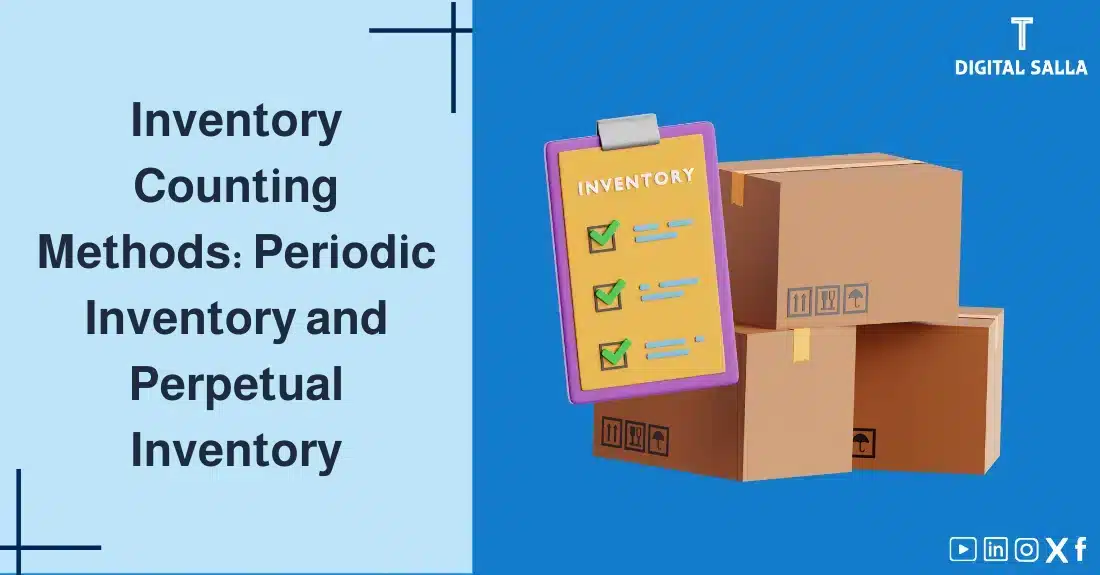Inventory Counting Methods: Periodic Inventory and Perpetual Inventory

Inventory counting is an essential process in any entity that deals with physical goods. It helps determine the quantity and value of goods held by the entity at the end of the financial period. The Inventory Counting Methods used vary from one entity to another, according to the accounting policies adopted by it
. The choice depends on the nature of the business, the volume of transactions, and the internal control system in place. In this article, we will discuss the main Inventory Counting Methods, namely periodic inventory and perpetual inventory, and clarify the difference between them, stating the advantages and disadvantages of each method, in addition to explaining how the choice of inventory counting method affects inventory valuation and financial statements.
What is Inventory Counting?
Inventory counting is the process of counting, weighing, or measuring the quantity of goods in an entity’s warehouses at a specific date, usually at the end of the financial period. The purpose of inventory counting is to verify the accuracy of the inventory balance recorded in the accounting books and to match it with the actual balance on hand.
Importance of Inventory Counting:
- Determining the Cost of Goods Sold: Inventory counting helps determine the cost of goods sold during the financial period, which is used to calculate gross profit and net profit.
- Inventory Valuation: Inventory counting enables the determination of the inventory value at the end of the financial period, which is shown on the balance sheet.
- Inventory Control: Inventory counting helps detect any shortages, damage, or theft of inventory, enabling the entity to take necessary corrective actions.
- Purchasing Planning: Inventory counting provides accurate information about the quantity of goods in the warehouses, which helps in planning future purchases and avoiding inventory shortages or overstocking.
- Decision-Making: Inventory count data provides important information that helps management make decisions related to product pricing, reorder points, and evaluating the efficiency of inventory management.
Inventory Counting Methods:
There are two main methods for inventory counting:
- Periodic Inventory System:
- Definition: It is an Inventory Counting Methods
- in which inventory is physically counted at the end of each financial period (or at regular intervals during the year). Inventory movement is not tracked continuously during the period.
- Mechanism:
- At the beginning of the period, the inventory balance is known (based on the previous count).
- During the period, all purchases of goods are recorded in a “Purchases” account.
- At the end of the period, a physical inventory count is performed to determine the quantity and value of the remaining goods.
- Cost of Goods Sold = (Beginning Inventory + Purchases) – Ending Inventory
- Advantages of Periodic Inventory:
- Simple and Easy to Implement: Does not require a complex system to track inventory movement.
- Low Cost: Does not require significant investments in inventory systems or specialized software.
- Suitable for Small Businesses: The periodic inventory system suits small businesses with limited quantities and types of inventory.
- Disadvantages of Periodic Inventory:
- Lack of Up-to-Date Information on Inventory Balance: The inventory balance cannot be known accurately until the end of the period when the physical count is performed.
- Difficulty in Inventory Control: Periodic inventory does not provide effective control over inventory during the period, which may expose it to theft or damage.
- Inaccuracy of Cost of Goods Sold: The cost of goods sold calculated at the end of the period may not reflect the actual cost of sales, especially if purchase prices have changed significantly during the period.
- Requires Business Interruption: Periodic inventory may require stopping work in the warehouses for a period of time to complete the counting process.
- Perpetual Inventory System:
- Definition: It is an Inventory Counting Methods in which inventory movement is tracked continuously and permanently, where every purchase, sale, or return of goods is recorded in stock cards or in a computerized accounting system.
- Mechanism:
- A separate stock card is created for each type of goods, recording all incoming, outgoing, and remaining balance movements.
- The inventory balance in the stock cards or in the computerized system is updated immediately after each transaction.
- The inventory balance of each item can be known at any time without the need for a physical count.
- Advantages of Perpetual Inventory:
- Provides Up-to-Date Information on Inventory Balance: The inventory balance of each item can be known at any moment.
- Effective Inventory Control: Perpetual inventory provides continuous control over inventory, which helps in detecting any shortages, damage, or theft immediately.
- Accurate Determination of Cost of Goods Sold: The cost of goods sold is calculated continuously, providing more accurate information for pricing decisions.
- Facilitates Planning: Perpetual inventory provides accurate data on inventory movement, which helps in planning purchasing and production operations better.
- Does Not Require Business Interruption: Physical inventory counts can be performed continuously or at close intervals without the need to completely stop operations.
- Disadvantages of Perpetual Inventory:
- High Cost: Perpetual inventory requires investments in inventory systems and specialized software, in addition to employee training costs.
- Relative Complexity: Perpetual inventory requires a more complex accounting system and accuracy in recording transactions.
- Not Suitable for Some Activities: Perpetual inventory may not be suitable for entities that deal with a large number of similar, low-value items.
Key Differences Between Inventory Counting Methods (Periodic and Perpetual):
| Feature | Periodic Inventory | Perpetual Inventory |
|---|---|---|
| Timing of Count | At the end of the financial period | Continuous |
| Cost of Goods Sold | Calculated at the end of the period | Calculated continuously |
| Inventory Balance | Known only at the end of the period | Known at any time |
| Inventory Control | Weak | Strong |
| Cost | Low | High |
| Complexity | Simple | Relatively Complex |
Impact of Inventory Counting Methods on Inventory Valuation and Financial Statements:
The choice of inventory counting method (periodic or perpetual) affects how inventory is valued at the end of the financial period, and consequently, the value of the cost of goods sold, net profit, and net assets in the financial statements.
- Periodic Inventory: Inventory is valued at the end of the period based on the physical count, and the cost of goods sold is calculated using an equation.
- Perpetual Inventory: Inventory is valued continuously, and the cost of goods sold is automatically updated after each sale.
Example:
Assume an entity has 100 units of a certain item at the beginning of the period, with a unit cost of 10 Riyals. During the period, it purchased 200 units at a cost of 12 Riyals per unit and sold 250 units.
Using the Periodic Inventory Method:
If the physical count at the end of the period showed 50 units remaining, the cost of goods sold is calculated as follows:
- Cost of Beginning Inventory = 100 units × 10 Riyals = 1,000 Riyals
- Cost of Purchases = 200 units × 12 Riyals = 2,400 Riyals
- Cost of Goods Available for Sale = 1,000 + 2,400 = 3,400 Riyals
- Cost of Ending Inventory = 50 units × 12 Riyals = 600 Riyals (assuming LIFO is used)
- Cost of Goods Sold = 3,400 – 600 = 2,800 Riyals
Using the Perpetual Inventory Method:
The cost of goods sold will be calculated continuously with each sale, based on the inventory valuation method used (FIFO, LIFO, Weighted-Average).
Role of Technology in Inventory Counting:
Modern technology provides many tools that facilitate the inventory counting process, such as:
- Inventory Management Software: These programs help track inventory movement accurately and provide up-to-date information on inventory balances and the cost of goods sold.
- Barcode Scanners: Used to scan the barcode of each item, which speeds up the counting process and reduces errors.
- Radio Frequency Identification (RFID): This technology allows for tracking and monitoring inventory movement automatically and accurately without the need to scan each item individually.
Factors Influencing the Choice of Inventory Counting Method:
- Nature of the Entity’s Business: The periodic inventory method is suitable for entities that deal with a small number of high-value items, while the perpetual inventory method is suitable for entities that deal with a large number of low-value items.
- Size of the Entity: The periodic inventory method is suitable for small entities, while the perpetual inventory method is suitable for large entities.
- Cost of Implementing Each Method: The perpetual inventory method requires higher costs than the periodic inventory, as it requires specialized systems and software.
- Level of Control Required over Inventory: The perpetual inventory method provides a higher level of control over inventory compared to the periodic inventory.
- Entity’s Technological Capabilities: The effective implementation of perpetual inventory depends on the availability of sophisticated systems and software for inventory management.
Conclusion:
Choosing the appropriate Inventory Counting Methods (periodic or perpetual) is an important decision that affects the accuracy of financial data and the efficiency of inventory management. Each entity must carefully evaluate its needs and circumstances before making this decision. Regardless of the chosen method, from the methods of inventory counting inventory counting remains a necessary process to ensure the integrity of the entity’s assets, the accuracy of its financial information, and the making of effective administrative and financial decisions. Understanding inventory Counting Methods and the advantages and disadvantages of each method is essential for every accountant and business owner.
